IB PHYSICS HL(Higher level) – 2024 – Practice Questions- All Topics
Topic 11.1 Electromagnetic induction
Topic 11 Weightage : 5 %
All Questions for Topic 11.1 – Electromotive force (emf) , Magnetic flux and magnetic flux linkage , Faraday’s law of induction , Lenz’s law
Question
The conservation of which quantity explains Lenz’s law?
A Charge
B Energy
C Magnetic field
D Mass
▶️Answer/Explanation
Ans: B
LENZ’S LAW
Question
A conducting ring encloses an area of 2.0 cm2 and is perpendicular to a magnetic field of strength 5.0 mT. The direction of the magnetic field is reversed in a time 4.0 s. What is the average emf induced in the ring?
A 0
B. 0.25 μV
C. 0.40μV
D. 0.50μV
▶️Answer/Explanation
Ans: D
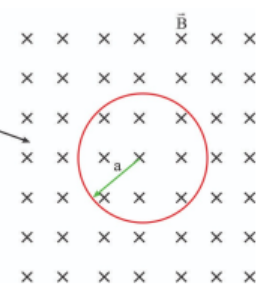
Faraday’s Law of Induction
FARADAY’S LAW OF ELECTROMAGNETIC INDUCTION
\(\phi_2 = -BA\) ( as direction of B is reversed)
hence \(\Delta \phi = \phi_2 -\phi_1 =2BA\)
Time taken for \(\phi\) to change \(= 4 s\)
Hence
\(e =-\frac{\Delta \phi}{\Delta t} =-\frac{-2\times B \times A}{4}\)
\(=\frac{2\times 2 \times 10^{-4} \times 5 \times 10^{-3}}{4}=5\times 10^{-7} =0.5 \mu T\)
Question
A uniform magnetic field directed into the page occupies a region of width L. A conducting coil of width L moves at constant speed v, from left to right, through the field.
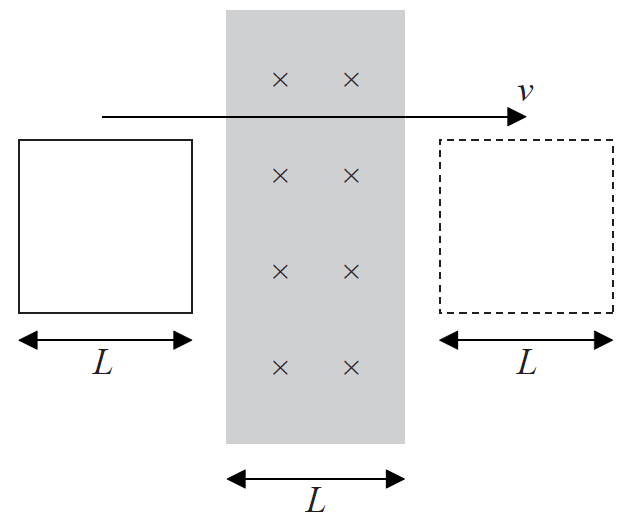
From the instant that the coil enters the field until the instant that the coil leaves the field, which of the following best describes the direction of the current induced in the coil?
A. Anti-clockwise
B. Clockwise
C. Anti-clockwise then clockwise
D. Clockwise then anti-clockwise
▶️Answer/Explanation
Markscheme
C
As the square is entering the field the flux linkage is increasing, while as it is leaving the linkage is decreasing. As per Lenz’s Law , direction of the current is such as to try to reduce the change in flux linkage.
Hence it should set up a magnetic field out of the page as the loop enters the field. and into the page when loop is leaving the magnetic field
Hence answer is C
Question
The current I flowing in loop A in a clockwise direction is increasing so as to induce a current both in loops B and C. All three loops are on the same plane.
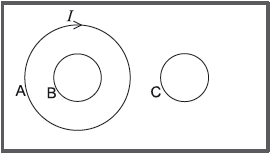
What is the direction of the induced currents in loop B and loop C?
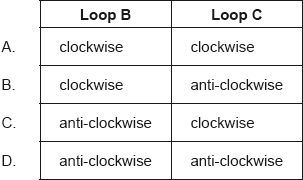
▶️Answer/Explanation
Markscheme
C
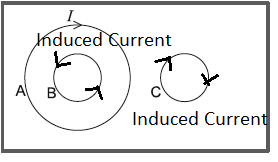
As per Lenz’s Law , direction of the current is such as to try to reduce the change in flux linkage. As current in circle A increases , this will increase linked flus to circle B and hence induced current will try to reduce this change and hence induced current will be in anti clock wise.
Similarly current goes downward near circle C , it will induced a current upward in circle C.
Question
A coil of area A is placed in a region of uniform horizontal magnetic field B. At t=0, the coil starts to rotate with constant angular speed ω about a horizontal axis.
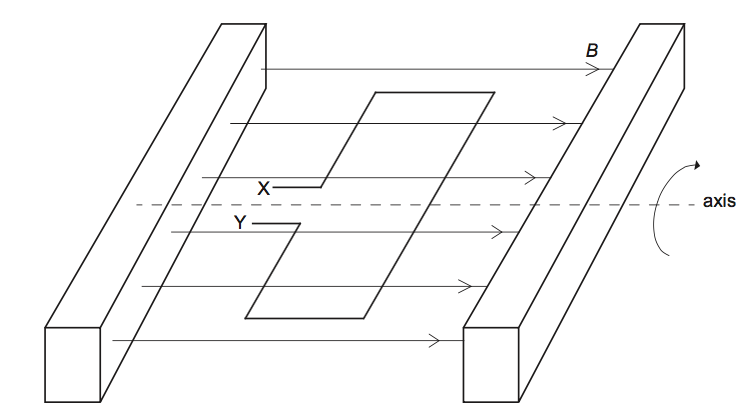
What is the emf between X and Y?
A. zero
B. ωAB sin ωt
C. AB cos ωt
D. −ωAB sin ωt
▶️Answer/Explanation
Markscheme
A
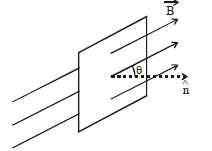
Hence
\(cos\;90^{\circ} =0\)
or
hence
Question
Faraday’s law of electromagnetic induction states that the electromotive force (emf) induced in a conductor is proportional to
A. the change of magnetic flux density.
B. the change of magnetic flux linkage.
C. the rate of change of magnetic flux density.
D. the rate of change of magnetic flux linkage.
▶️Answer/Explanation
Markscheme
D
FARADAY’S LAW OF ELECTROMAGNETIC INDUCTION
Question
The diagram shows a loop L of wire in a uniform magnetic field B.
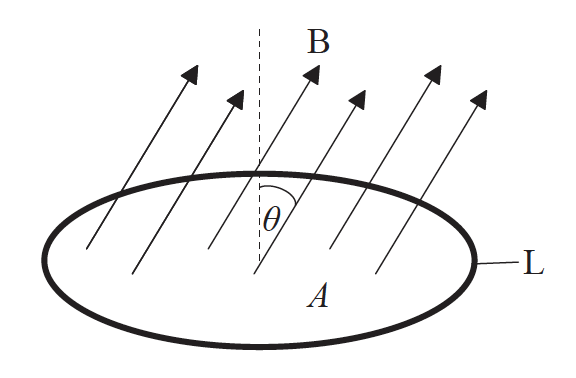
The loop encloses an area A and the field is directed at an angle θ to the normal to the plane of the loop. The strength of B is increasing at a uniform rate R. What is the emf induced in L?
A. \(\frac{{RA}}{{\cos \theta }}\)
B. RA cos θ
C. \(\frac{{RA}}{{\sin \theta }}\)
D. RA sin θ
▶️Answer/Explanation
Markscheme
B
\(\phi = BA cos\theta\)
hence \(e =-\frac{d\phi}{dt} =-\frac{d(BA cos\theta)}{dt} =-A cos \theta \frac{dB}{dt}\)
since \(\theta\) and Area \(A\) is constant
Hence
\(e =-A cos \theta \times R\)